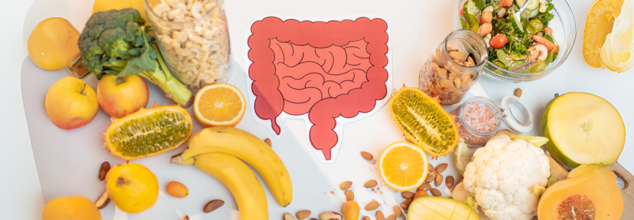- Health Conditions A-Z
- Health & Wellness
- Nutrition
- Fitness
- Health News
- Ayurveda
- Videos
- Medicine A-Z
- Parenting
- Web Stories
This So-Called Healthy Routine May Be Ruining Your Gut from the Inside

Credits: Canva
For decades, gut health was treated as a special issue but as research keeps revealing the central role that the gut microbiome plays in everything from immunity to mood, the world is now taking notice. Some of the same habits that individuals form under the banner of health and wellness may be quietly sabotaging the microbial ecosystem inside, an ecosystem so important that researchers now call it a "second brain."
From sugar-free treats to fad diets, numerous "clean living" habits might be doing more harm than good. Let's understand the overlooked risks hidden behind these healthy-looking habits and see how you can help your gut thrive for years to come.
Ultra-Processed "Health" Foods
That protein bar you stash in your gym bag? That low-calorie snack you munch between Zoom meetings? Although they might look like good decisions, many ultra-processed foods have a health halo that's partially illusory. Foods with "diet-friendly" or "low-fat" labels tend to use emulsifiers, artificial sweeteners, preservatives, and other additives for shelf life extension or flavor enhancement — but these substances wreak havoc on the gut microbiome.
Scientific research has demonstrated that widespread additives such as polysorbate 80 and carboxymethylcellulose — often contained in processed snacks — will change microbial makeup and enhance intestinal permeability, otherwise known as "leaky gut." Such a condition will potentially lead to increased vulnerability for inflammatory disease, metabolic illness, and even mood instability.
Antibiotics are certainly life-saving when prescribed rightly. But the excess usage and misuse of these drugs have resulted in extensive collateral damage. Antibiotics aren't finicky they decimate good gut bacteria along with bad germs, rendering your microbiome weak and depleted.
Frequent use of antibiotics, particularly for viral infections (which antibiotics are ineffective for), is linked with long-term microbial imbalance. This can lead the way to gastrointestinal ailments, compromised immunity, and repeated infections.
Rather than resorting to antibiotics, try a "watch and wait" for low-level infections. Ask your doctor whether medication is really needed, and if prescribed, take the antibiotic course together with probiotics — before, during, and after treatment — to restore healthy bacteria.
Why Restrictive Dieting Might Be To Blame?
In the keto, paleo, Whole30, and elimination diets age, "clean eating" has come to equate with eliminating entire food groups. Though a temporary restriction here or there may aid in the determination of food sensitivities, extended elimination of a varied group of plant foods will deprive the microbiome of the fiber and polyphenols necessary for health.
Microbial diversity is a keystone of good gut health. A study from the American Gut Project reveals that individuals eating 30+ diverse plant foods per week possess more resilient and diverse microbiomes compared to those eating restrictive diets. Diversity isn't simply eating more fruits and vegetables — it's also adding legumes, nuts, seeds, whole grains, and fermented foods.
Why Artificial Sweeteners Are Not So Sweet for Your Gut?
Sugar substitutes can be helpful for keeping calories in check, but some research has concluded that non-nutritive sweeteners sucralose and aspartame can upset the balance and function of gut bacteria. Such alterations impair glucose tolerance, disrupt insulin sensitivity, and ironically lead to weight gain — the exact opposite of what many are trying to prevent by using these products.
Alternatives are best in the form of small quantities of natural sweeteners such as raw honey or maple syrup or less invasive alternatives like monk fruit extract. Even better, habituate your taste buds to love the natural sweetness within whole foods, bypassing the need for added sugars altogether.
Are Cooking Oils A Hidden Gut Barrier Threat?
We’re often told to avoid saturated fats in favor of vegetable oils like corn, canola, and soybean oil — but this advice might come with unintended consequences. These oils, often refined and rich in omega-6 fatty acids, have been associated with increased inflammation, particularly when consumed in excess.
Inflammation damages the gut lining and disrupts barrier function, which in turn leads to various chronic conditions. On the other hand, unprocessed oils like extra virgin olive oil, avocado oil, and ghee have bioactive molecules that maintain gut integrity and have anti-inflammatory action.
How to Rebuild a Healthier Gut?
If you’re realizing your well-intentioned habits may have damaged your microbiome, don’t despair. The gut is remarkably resilient — given the right environment, it can bounce back.
Begin by boosting the amount of fiber-dense, plant-based foods in your diet. Add fermented foods such as yogurt, kefir, kimchi, sauerkraut, and miso, which bring in beneficial probiotics. Cut back on artificial sweeteners, processed foods, and inflammatory oils. Supplement your gut lining with L-glutamine, zinc, and omega-3 fatty acids.
Lastly, take care of stress, exercise your body often, and sleep well. These lifestyle factors also affect your gut reminding us that health is never solely about what we consume.
Healthy trends are tantalizing, they deliver quick gains and easy fixes in a world that is getting more complicated by the minute but when it comes to the gut, shortcuts only end in reverse. A really healthy gut takes more than supplements and low-calorie marks — it thrives on balance, diversity, and consistency.
Wonder Why Your Head Won’t Stop Pounding? Time To Check Your Oral Care Routine

Credits: Canva
If you’re one of the millions of women struggling with unexplained headaches, body pain, or even fibromyalgia—and you’ve ruled out the usual suspects like stress, sleep, or hormones—it may be time to look inside your mouth. Literally.
A powerful new study in Frontiers in Pain Research revealed a strong link between bad oral hygiene and higher risk of migraines and chronic body pain. The study implies that neglecting your morning brushing and flossing isn't just exposing your teeth to harm—perhaps it's also driving silent inflammation that amplifies pain sensitivity throughout the body.
Link Between Oral Microbes and Chronic Pain
In a joint study at the University of Sydney, scientists studied 158 New Zealand women, all of whom received thorough dental examinations and gave saliva samples for microbial testing. They compared their self-reported history of migraines, fibromyalgia, and abdominal pain to both their oral health and microbiota. The findings were remarkable.
Women with the poorest oral health—characterized by higher levels of plaque, gum disease, and inflammation—had a 49% greater chance of experiencing migraines and were 60% more likely to experience moderate to severe body pain.
“We’ve long known that oral microbes play a role in systemic inflammation,” said lead researcher Sharon Erdrich, a doctoral candidate at the University of Sydney. “But this is the first study to show a clear link between poor oral health and the kind of widespread pain experienced in fibromyalgia and migraine sufferers.”
Why Bacteria in Your Mouth Might Be Messing With Your Brain?
The mouth, with more than 700 microbial species calling it home, is an intricate ecosystem. When brushing and flossing routines fail, bad bacteria flourish. These microbes create chemicals that can stimulate inflammation, disrupt neurotransmitter signals, and modulate the nervous system's ability to perceive pain.
Senior researcher Joanna Harnett described how these pain-causing microbial products may pass into the bloodstream and impact pain processing centers in the brain, making one more sensitive to pain.
"Sleep disturbances, headaches, and fatigue—all the hallmarks of fibromyalgia—can have a microbial cause, and it starts in oral hygiene," said Harnett.
What is Fibromyalgia?
Fibromyalgia is a chronic condition characterized by widespread musculoskeletal pain, tender points, fatigue, sleep disturbances, and cognitive problems. It is most commonly found in women aged 20-50 and is notoriously hard to diagnose, going undiagnosed or misdiagnosed for years.
Although the precise etiology is not known, the syndrome has been thought to be related to aberrations in pain signal processing in the brain. There is also emerging evidence of interaction among the immune system, gut microbiota, and recently, the oral microbiome.
Surprising Symptom in Your Mouth
For women who experience fibromyalgia or migraines, symptoms tend to flare at random. This research now adds that the status of oral health could be an untapped piece in the diagnostic picture.
Four different microbial species were found to be more common in women who complained of increased pain severity. Researchers are convinced that these microbes affect inflammatory pathways that render receptors for pain more active and sensitive.
This research isn't merely providing an intriguing microbial connection—it's a wake-up call about how we do oral hygiene.
From being a mere topic of pearly whites and good breath, brushing and flossing are now starting to be viewed as weapons in the fight against chronic pain. Better oral hygiene may be an inexpensive, easy-to-reach solution for individuals struggling with migraine, fibromyalgia, or otherwise unexplained pain in the body.
We also hope these findings inspire healthcare professionals to include oral care evaluations in pain treatment plans," Erdrich said. "Particularly for women with chronic, difficult-to-treat diseases."
Tips to Maximize Your Oral Health And Ease the Pain
- Brush twice daily with fluoride toothpaste and floss once a day.
- Drink enough water to promote healthy saliva flow, which keeps bacteria in check.
- Avoid sweet foods and acidic drinks that fuel nasty microbes.
- Schedule regular dental check-ups every six months.
- Use an antibacterial mouthwash if advised by a dental professional.
Although further research is required to comprehend precisely how oral bacteria regulate pain, this research contributes to a mounting body of evidence that the mouth is considerably more linked to overall health than previously believed.
Recovering From A Heart Attack? Avoid These Dangerous Mistakes

A heart attack marks a life-altering moment, one that demands more than just medication and doctor visits. It calls for a complete reimagining of daily habits, especially around one of the most overlooked yet consequential risk factors: prolonged sitting.
While conventional recovery advice has long emphasized formal exercise routines, groundbreaking new research suggests that something as simple as reducing sedentary time—and replacing it with even light physical movement or additional sleep can dramatically lower the risk of another cardiac event.
A recent study published in Circulation: Cardiovascular Quality and Outcomes has illuminated a critical insight: lounging too much after a heart attack may be setting survivors up for a repeat episode—or worse.
Here's why sitting is so risky and what you can do to truly recover—not just survive—after a heart attack.
Avoid The 14-Hour Sedentary Trap
In a prospective study that followed over 600 adults, researchers tracked heart attack and chest pain patients for a year after discharge from Columbia University Medical Center. Using wearable movement-tracking devices, they found that individuals who were sedentary for more than 14 hours a day faced more than double the risk of experiencing another heart-related event—or even dying.
Patients in the most inactive group were 2.5 times more likely to suffer complications than their more mobile peers. It wasn’t just about formal workouts—total movement throughout the day, including light activity and even sleep, was associated with better outcomes.
More physical activity and more sleep are healthier than sitting, one doesn’t have to start running marathons after a cardiovascular event to see benefits.
What Happens When You Replace Sitting?
What makes this study especially impactful is the practical takeaway: you don’t need to engage in strenuous gym sessions to gain protection. Swapping just 30 minutes of sedentary time with:
Moderate-to-vigorous activity (e.g., brisk walking or cycling) slashed the risk of another event or death by 61%.
Light activity (e.g., casual walking or doing chores) cut risk by 50%.
Even sleep lowered risk by 14%, underlining the restorative value of proper rest.
We were surprised that replacing sedentary time with sleep also lowered risk. Sleep is a restorative behavior that helps the body and mind recover, which is especially important after a serious health event like a heart attack.
These findings offer a lifeline to many patients who struggle with intensive exercise, especially older adults or those with mobility limitations.
What Really Counts as Heart-Healthy Physical Activity?
The American Heart Association recommends at least 150 minutes per week of moderate-intensity aerobic activity, or 75 minutes of vigorous-intensity movement, ideally spread throughout the week. You don’t have to hit the gym daily; even a brisk 30-minute walk five times a week checks the box. How do you gauge intensity?
What Qualifies As Physical Activity?
Moderate activity raises your heart rate and gets you breathing harder—you can talk but not sing.
Examples: walking fast, dancing, biking on flat terrain, doubles tennis, pushing a lawnmower.
Vigorous activity means you're breathing hard and fast—speaking more than a few words becomes difficult.
Examples: running, swimming laps, biking uphill, singles tennis.
But if you’re fresh from a cardiac event, even just standing, stretching, walking around your home, or cooking a meal counts toward meaningful movement. The key is to avoid long, uninterrupted bouts of sitting.
Why Sleep is Important For Cardiac Recovery?
Though often overshadowed by diet and exercise, sleep is emerging as a potent force in post-heart attack healing. Replacing sedentary time with extra sleep—particularly for those who may be chronically sleep-deprived—was linked to a tangible reduction in risk.
Adequate sleep (typically 7–9 hours for adults) aids in regulating blood pressure, reducing stress hormones, and optimizing metabolic function—all of which are critical in cardiac recovery.
Lifestyle Changes To Follow or Better Recovery
This study challenges the one-size-fits-all narrative of cardiac recovery. Instead of prescribing just exercise, experts are now urging clinicians and patients alike to adopt a more holistic, flexible, and personalized approach that includes:
- Reducing sedentary behavior in any form
- Encouraging light physical movement as often as possible
- Prioritizing good-quality sleep
- Shifting the mindset from structured workouts to continuous movement throughout the day
Recovery doesn’t require an Olympic regimen. What matters most is your daily rhythm—how often you move, how well you sleep, and how little time you spend motionless. Standing up during a phone call, walking a few extra steps during lunch, or going to bed 30 minutes earlier can all add up to a healthier heart.
Surviving a heart attack is just the first step. Thriving afterward depends on small, consistent actions that respect the body's need for motion and rest.
This Simple 60 Second Test Could Reveal Early Signs Of Dementia

(Credit-Canva)
One of the hardest things many people go through is losing their memories. Slowly forgetting your loved ones, the memories that you formed with them, essentially losing a huge part of yourself and this disease is sadly not an uncommon one. Dementia affects millions of people thought the globe. The World Health Organization said 57 million people all over the world had dementia in 2021, with nearly 10 million new cases every year.
One of the most unfortunate parts of this disease is that the causes of it are now well known, new studies are done regularly to find out things that affect dementia, early signs and cures as well. However, till date, the best way to tackle this disease is by catching its early signs and slowing down the disease.
Spotting the first signs of dementia can be tough, but a quick 60-second test might reveal if you have mild cognitive impairment, which can sometimes lead to the condition. This tests is explained in a 2007 article published the journal Psychiatry. This simple test involves naming as many items as you can within a chosen category.
Category Naming" Test
This easy test simply asks you to pick a common category, for example, animals, and then try to name as many different objects or types of animals that fit into that group as quickly as you can. A study from 2007 suggested that if you can name over 21 things, you are probably fine. However, if you struggle to name 15 or more, it could mean you have cognitive impairment, which significantly increases your risk of Alzheimer's disease—potentially by 20 times.
"Letter Word" Test
Another useful variation of this quick mental check involves asking you to say as many words as you can that begin with a specific letter, such as "F," all within a strict one-minute timeframe. Combining the results from this "letter word" test with the "category naming" test can provide valuable hints about the specific type of memory or thinking problem someone might be experiencing. For instance, if you find it noticeably harder to list words starting with "F" compared to naming items in a group, it could point towards vascular dementia.
Mini-Cog Test
Researchers have also described a third helpful assessment called the Mini-Cog test. This test involves two simple steps: first, you're asked to remember three unrelated words, and then you draw a clock face. After drawing the clock, you are asked to recall the three words. If you can easily remember all the words, it generally suggests your memory is good and you likely don't have dementia. If you only remember one or two words, the accuracy of your clock drawing then becomes a crucial factor in the assessment.
Why Early Detection Matters
It's estimated that around one million people in the UK are currently living with dementia, but a significant portion, about one-third, haven't been officially diagnosed. Identifying the underlying diseases that cause dementia at an early stage is incredibly important. Early diagnosis allows individuals to access vital treatments and support services sooner, which can help manage symptoms, improve their quality of life, and allow them to plan for the future more effectively.
© 2024 Bennett, Coleman & Company Limited

